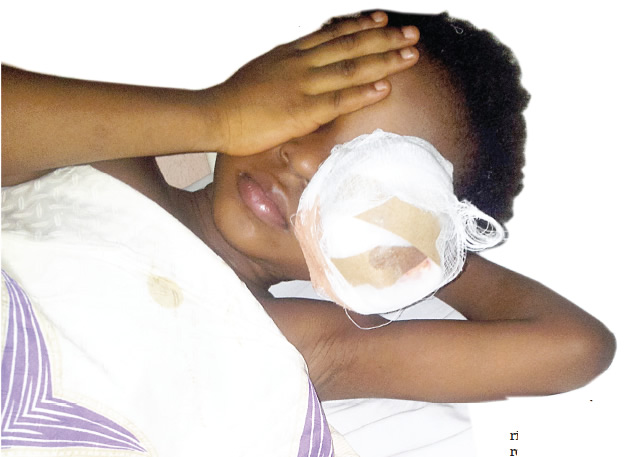* Situation worse in children
* Patient abandonment rife due to high cost of treatment
Six-year-old Oyinade Awelewa is completely blind and disfigured in one eye. Her doctors, consultant paediatrician, Prof. Edamisan Olusoji Temiye, Prof. Akinsule and senior resident paediatrician Dr Oluwakayode Omidiji of Lagos University Teaching Hospital (LUTH), confirmed she has retinoblasma, a cancer that starts in the retina, the eye balls, and spreads to other parts of the body.

If untreated, Prof. Temiye says, the retinoblasma cells could grow along the optic nerve and reach the brain, the covering layers of the eyeballs, into the eye socket, eye lids and nearby tissues. Once the tissues outside the eyeballs are affected, the cancer may then spread to the lymph nodes (small bean-shaped collections of immune system cells) and to other organs such as the liver, bones and bone marrow (the soft inner part of many bones).
Retinoblasma, if detected and treated early, can be cured, but Onyinade’s case had already degenerated and the next best thing now was to remove the eye balls following series of chemotherapy. Dr. Omidiji says Onyinade will have to go through two chemotherapy session before the surgery and another session after surgery, and during these treatments, she will have to endure pain and some unpleasant side effects, depending on how her body reacts to it.
But Onyinade was not born with this condition, according to his distraught dad, Adebayo Awelewa, a carpenter in Idimu, a Lagos suburb who also recently lost his wife.
“It started with a white spot, like cat eyes appearing on her eye balls two years back, then it started to enlarge, and then she could not see with the eye. We went to Lagos State University Teaching Hospital LASUTH on the 5th of September 2012 but were told to report back after six months. Thereafter we were referred to Guinness eye care, in LUTH.”
Mr. Awelewa said in-between those periods, his wife fell sick and eventually died and because of financial constrain, Onyinade’s case was put on hold until recently when she was eventually admitted at the children’s emergency ward in LUTH. The affected eye has started to swell and had deteriorated. Presently, Onyinade has completed one chemotherapy session. She has been discharged and will have to return three weeks later for the second session before the operation.
But Mr. Awelewa is groaning under the financial burden the disease has placed on him, the total cost of treatment and medical expenses has been estimated to one million Naira, and he has no idea how he would continue paying.
“This is the point where they all abscond from treatment and the next thing you will hear is that the patient is dead,” says Prof. Edamisan Temiye who explained that the cure rate for childhood cancer is
extremely low as eighty percent of children with cancer end up dead because of treatment abandonment.
Indeed, a recent study at LUTH’s paediatric department over a period of 18 months revealed that 168 out of 540 admissions were due to cancer, the cure rate for these admissions was found to be below 20 percent. This is extremely low compared to developed countries where you have up to 80 percent cure rate. In Netherland, for instance, the cure rate is reported to be 92 percent.
Matron, Dr Nneka Nwobbi and founder of Children Living with Cancer Foundation (CLWCF) also confirmed the high death rate saying it is a common occurrence in our environment for parents to default in treatment. “We found out that most parents default in their treatment and when they do, these children all end up dead. However, some might return when the case is too severe and all we can do is give palliative treatment which does not cure, except to alleviate the pain before the child finally passes on.”
She also said the foundation had recently lost four kids who were present during their Christmas party on the 10th of December, between then and now. Mrs. Patience Eghe Okoro, a Matron at the paediatric ward LUTH, however cited finance as the major challenge faced by parents of affected children and this, she says is the reason why many of them run away from completing treatment.
For instance, according to her, leukaemia could cost up to 10 to 15 million naira with bone marrow transplant inclusive within a two to three years period.
“Some cost less than this; To treat nephroblastoma in Lagos costs between N186, 000 and N240, 000 for six months, without surgery, all the treatment is usually expensive for the poor people who are the ones that bring their children for treatment in LUTH. The rich ones who can afford the money take their children abroad for treatment. That is one reason our cure rate is very low. The parents come and when they see the enormous cost, they just walk away. And the next time you see them, they tell you the child died at home.”
The International Network for Cancer Treatment and Research (INCTR), also attributed the high death rate of children with cancer to delays in diagnosis leading to presentation with advanced disease. Poor patients receive affordable or available treatment, not optimal treatment hence many patients go home and die. The organisation also noted that an unknown number of the children never even make it to the centres capable of providing treatment for the disease.
The World Health Organization (WHO) had projected that cancer would overtake ischemic heart disease as the leading cause of death in the world and the second leading cause of death after accidents in children less than 15 years. Statistics also show that one in 300 children will have cancer before the age of 16. Already, more than 70% of global cancer deaths occur in low and middle income countries.


Comments are closed.